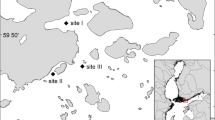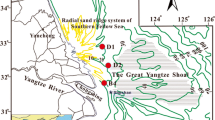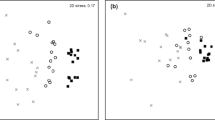Abstract
Accurate measurement of intertidal sediment erodibility is essential for the development of meaningful and accurate models of sediment dynamics. Despite considerable advances in technology and methodology, the measurement of cohesive intertidal sediment erosion remains problematic. Sediment erodibility varies according to both physical and biological properties and processes. These cannot be considered in isolation, as they can interact to create both positive and negative feedbacks, resulting in seemingly idiosyncratic responses in the system. If working models of estuarine sediment dynamics are to be made, it is essential that the influence of these processes on both the measurements and the system itself be considered. Recent developments in measurement technology enable rapid measurement of sediment stability allowing temporal and spatial variability to be measured on a time scale of minutes. This paper reports temporal variability in cohesive intertidal sediment erosion threshold related to immersion and emersion, and the concomitant responses in selected sediment properties (carbohydrates, water content and chlorophyll). Erosion threshold tended to increase over emersion and decrease over immersion, although the patterns of change varied depending upon local conditions, and in one case there was no temporal trend. Temporal changes resulted in a range of measured erosion threshold, dependant upon the erosion device used. Modifications to existing methodology, in order to account for this variation, are proposed and implications for modelling erosion processes are considered.
Similar content being viewed by others
References
Amos C.L., Van Wagoner N.A. and Daborn G.R. 1988. The influence of subaerial exposure on the bulk properties of fine grained intertidal sediment from Minas basin Bay of Fundy. Estuar. Coast. Shelf Sci. 27: 1–13
Amos C.L., Daborn G.R., Christian H.A., Atkinson A., Robertson A. (1992). In situ erosion measurements on fine grained sediments from the Bay of Fundy. Marine Geology 108: 175–96
Black K.S., Paterson D.M. (1997). Measurement of the erosion potential of cohesive, marine sediments: a review of current in situ technology. Journal of Marine Environmental Engineering 4(1): 43–84
Black K.S., Paterson D.M. and Cramp A. (eds), (1998). Sedimentary Processes in the Intertidal Zone, Geological Society. Special Publications, London, 139 pp.
Black K.S., Tolhurst T.J., Hagerthey S.E., and Paterson D.M., (2002) Working with Natural Cohesive Sediments. Journal of Hydraulic Engineering 128(1): 2–7
de Brouwer J.F.C., Bjelic S., de Deckere E.M.G.T., Stal L.J. (2000) Interplay between biology and sedimentology in a mudflat (Biezelingse Ham, Westerschelde, The Netherlands). Continental Shelf Research 20: 1159–1177
Christie M.C. and Dyer K.R. (1998). Measurements of the turbid tidal edge over the Skeffling mudflats. In: Black K.S., Paterson D.M., Cramp A. (eds), Sedimentary Processes in the Intertidal Zone. Geological Society, London, Special Publications, 139: 135–148
Dade W.B., Davis J.D., Nichols P.D., Nowell A.R.M., Thistle D., Trexler M. B., White D.C. (1990). Effects of bacterial exopolymer adhesion on the entrainment of sand. Geomicrobiology Journal 8: 1–16
Defew E.C., Tolhurst T.J., Paterson D.M. (2002) Site-specific features influence sediment stability of intertidal flats. Hydrology and Earth System Sciences 6(5): 971–981
Defew E.C., Tolhurst T.J., Paterson D.M. and Hagerthey S.E. 2003. Can the stability of intertidal sediments be predicted from proxy parameters? An in situ investigation. In: Estuarine and Coastal Sciences Association. 2003. Coastal Zone Topics, 5. The estuaries and coasts of north-east Scotland, Aberdeen, Estuarine and Coastal Sciences Association, pp. 61–70
Dubois M., Gilles K.A., Hamilton J.K., Rebers P.A., Smith F. (1956). Colorimetric method for determination of sugars and related substances. Annals of Chemistry 28: 350–356
Friend P.L., Collins M.B., Holligan P.M. (2003) Day-night variation of intertidal flat sediment properties in relation to sediment stability. Estuarine Coastal and Shelf Science 58: 663–675
Gust G. 1991. Fluid velocity measuring instrument. U.S. Patent No. 4986: 122
Gust G. and Muller V. 1997. Interfacial dynamics and entrainment functions of currently used erosion devices. In: Burt et al. (eds), Proc. 4th Nearshore & Estuarine Cohesive Sediment Transport Conference INTERCOH ’94, July 1994, UK. CRC. 149–174
Honeywill C., Paterson D.M. and Hagerthey S.E. (2002). Determination of microphytobenthic biomass using pulse modulated minimum fluorescence. European Journal of Phycology 37: 1–8
de Jonge V.N., van Beusekom J.E.E. (1995). Wind and tide induced resuspension of sediment and microphytobenthos from tidal flats in the Ems estuary. Limnology and Oceanography 40: 766–778
Mwamba M.J. and Torres R. (2002) Rainfall effects on marsh sediment redistribution, North Inlet, South Carolina, USA. Marine Geology, 189: 267–287
Paphitis D., Velegrakis A.F., Collins M.B. and Muirhead A. (2001) Laboratory investigations into the threshold of movement of natural sand-sized sediments under unidirectional, oscillatory and combined flows. Sedimentology 48: 645–659
Paterson D. M. (1989). Short term changes in the erodibility of intertidal cohesive sediments related to the migratory behaviour of epipelic diatoms. Limnology and Oceanography 34(1): 223–234
Paterson D.M., Tolhurst T.J., Kelly J.A., Honeywill C. de Deckere E.M.G.T., Huet V., Shayler S.A., Black K.S., de Brouwer, J. and Davidson, I. (2000) Variations in sediment stability and sediment properties across the Skeffling mudflat, Humber estuary, UK. Continental Shelf Research 20: 1373–1396
Perkins R.G., Oxborough K., Hanlon A.R.M., Underwood G.J.C. and Baker N.R. (2002). Can chlorophyll fluorescence realistically be used to estimate the rate of photosynthetic electron transport within microphytobenthic biofilms? Marine Ecology Progress Series, 228: 47 – 56
Porra R.J., Thompson W.A., Kriedman P.E. (1989). Determination of accurate extinction coefficients and simultaneous equations for assaying chlorophylls a and b extracted with four different solvents: verification of the concentration of chlorophyll standards by atomic absorption spectroscopy. Biochimica et Biophysica Acta 975: 384–394
Sutherland A.J. 1966. Suspension of fine sediments by turbulent flows. W.M. Keck Laboratory of Hydraulics and Water Resources. Division of Engineering and Applied Science, California Institute of Technology, Pasadena, California. Report No. KH-R-13 199
Taylor I., Paterson D.M. (1998) Microspatial variation in carbohydrate concentrations with depth in the upper millimetres of intertidal cohesive sediments. Estuarine Coastal and Shelf Science 46: 359–370
Tolhurst T.J., Black K.S., Shayler S.A., Mather S., Black I., Baker K. and Paterson D.M. (1999) Measuring the in situ erosion shear stress of intertidal sediments with the Cohesive Strength Meter (CSM). Estuarine Coastal and Shelf Science 49: 281–294
Tolhurst T.J., Reithmüller R., Paterson D. M. (2000a) In situ versus laboratory analysis of sediment stability from intertidal mudflats. Continental Shelf Research 20: 1317–1334
Tolhurst T.J., Black K.S., Paterson D.M., Mitchener H., Termaat R. and Shayler S.A. (2000b) A comparison and measurement standardisation of four in situ devices for determining the erosion shear stress of intertidal sediments. Continental Shelf Research 20: 1397–1418
Tolhurst T.J., Gust G. and Paterson D.M. 2002. The influence of an extracellular polymeric substance (EPS) on cohesive sediment stability. In: Winterwerp J.C. and Kranenburg C. (eds), Fine Sediment Dynamics in the Marine Environment, Proceedings in Marine Science 5: 409–425
Tolhurst T.J., Jesus B., Brotas V. and Paterson D. M. (2003) Diatom migration and sediment armouring – an example from the Tagus Estuary, Portugal. Hydrobiologia 503: 183–193
Underwood G. J. C., Paterson D. M. and Parkes R. J. (1995). The measurement of microbial carbohydrate exoploymers from intertidal sediments. Limnology and Oceanography 40 (7): 1243–1253
Watts C.W., Tolhurst T.J., Black K.S. and Whitmore A.P. (2003) In situ Measurements of Erosion Shear Stress and Geotechnical Shear Strength of the Intertidal Sediments of the Experimental Managed Realignment Scheme at Tollesbury in Essex, UK. Estuarine and Coastal Shelf Science 56: 1–10
Whitehouse R.J.S. and Mitchener H. J. 1998. Observations of the morphodynamic behaviour of an intertidal mudflat at different timescales. In: Black K.S., Paterson D.M. and Cramp A. (eds), Sedimentary Processes in the Intertidal Zone. Geological Society, London, Special Publications, 139: 255–271
Williams J.J., Bell P.S., Humphery J.D., Hardcastle P.J. and Thorne P.D. (2003) New approach to measurement of sediment processes in a tidal inlet. Continental Shelf Research 23: 1239–1254
Wiltshire K.H., Blackburn J. and Paterson D.M. (1997). The Cryolander: A new method for in situ sampling of unconsolidated sediments minimising the distortion of sediment fabric. Journal of Sedimentary Research 67 (5): 977–981
Acknowledgements
This work was supported through the European project MAS3-CT98-0166-CLIMEROD and received additional support for T. J. Tolhurst during writing from the Centre for Research on Ecological Impacts of Coastal Cities, Sydney University.
Author information
Authors and Affiliations
Corresponding author
Rights and permissions
About this article
Cite this article
Tolhurst, T., Defew, E., Perkins, R. et al. The effects of tidally-driven temporal variation on measuring intertidal cohesive sediment erosion threshold. Aquat Ecol 40, 521–531 (2006). https://doi.org/10.1007/s10452-005-9001-7
Received:
Accepted:
Published:
Issue Date:
DOI: https://doi.org/10.1007/s10452-005-9001-7




